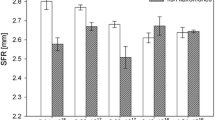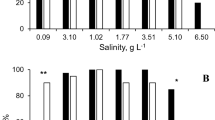Abstract
Individuals of Daphnia magna Straus living together in groups were found to influence each other in a density-dependent manner. The effect appeared as an inhibition in offspring production and was demonstrated to be induced in part or completely by metabolic products released by Daphnia itself (negative interference). Negative interference was measurable even when there were only two individuals in 50 ml medium (40 animals · 1−1) and increased up to a density of six animals per 50 ml (120 animals · 1−1). Also, animals living singly in Daphnia-conditioned water showed a decrease in reproduction. For the measurements a cascade of vessels was developed in which flow-through conditions ensured a constant concentration of algae throughout the system.
Similar content being viewed by others
References
Atema J (1985) Chemoreception in the sea: adaption of chemoreceptors and behaviour to aquatic stimulus conditions. In: Lavermack M S (ed) Physiological adaptation of marine animals. Soc Exp Biol Cambridge 39:387–423
Banta AM, Brown LA (1929a) Control of sex in Cladocera: I. Crowding the mothers as a means of controlling male production. Physiol Zool 2:80–92
Banta AM, Brown LA (1929) Control of sex in Cladocera: II The unstable nature of the excretory products involved in male production. Physiological Zoology 2:93–98
Banta AM, Brown LA (1930) Control of male and sexual-egg production. In: Banta AM (ed) Studies on the physiology, genetics and evolution of some Cladocera. Carnegie Inst Publ 513: 106–130
Burns CW (1969) Relation between filtering rate, temperature and body size in four species of Daphnia. Limnol Oceanogr 14: 693–700
Cox EJ, Naylor C, Bradley MC, Calow P (1992) Effect of differing maternal ration on adult fecundity and offspring size in laboratory cultures of Daphnia magna Straus for ecotoxicological testing. Aquat Toxicol 24:63–74
Elseth GD, Baumgardner KD (1981) Population biology. Van Nostrand, New York Cincinnati Toronto London Melbourne
Frank PW (1952) A laboratory study of intraspecies and interspecies competition in Daphnia pulicaria Forbes and Simocephalus vetulus O.F. Müller Physiol Zool 25:175–204
Frank PW, Boll CD, Kelly RW (1957) Vital statistics of laboratory cultures of Daphnia pulex DeGeer as related to density. Physiol Zool 30:287–304
Geller W (1975) Die Nahrungsaufnahme von Daphnia pulex in Abhängigkeit von der Futterkonzentration, der Temperatur, der Körpergröße und dem Hungerzustand der Tiere. Arch Hydrobiol Suppl 48:47–107
Gliwicz ZM, Guisande C (1992) Family planning in Daphnia: resistance to starvation in offspring born to mothers at different food levels. Oecologia 91:463–467
Guisande C (1993) Reproductive strategy as population density varies in Daphnia magna (Cladocera). Freshwater Biol 29: 463–467
Helgen JC (1987) Feeding rate inhibition in crowded Daphnia pulex. Hydrobiologia 154:113–119
Hessen DO, Donk E van (1993) Morphological changes in Scenedesmus induced by substances released from Daphnia. Arch Hydrobiol 127:129–140
Hobæk A, Larsson P (1990) Sex determination in Daphnia magna. Ecology 71:2255–2268
Hoeven N van der (1989) The population dynamics of Daphnia at constant food supply: a review, re-evaluation and analysis of experimental series from the literature. Neth Zool 39:126–155
Hommen U, Poethke HJ, Dülmer U, Ratte HT (1993) Simulation models to predict ecological risk of toxicants in freshwater systems. ICES J Mar Sci 50:337–347
Kersting K (1991) Recycling of food by Daphnia magna Strauss (Cladocera): a possible role in swarming. Hydrobiol Bull 25: 73–75
Kleiven OT, Larsson P, Hobæk A (1992) Sexual reproduction in Daphnia magna requires three stimuli. Oikos 65:197–206
Klüttgen B, Ratte HT (1993) Einfluß der Nahrungskonzentration auf Lebensdaten und Filtrierleistungen von Daphnia magna. D Ges Limnol Erweiterte Zusammenfassungen, I:180–184
Klüttgen B, Dülmer U, Engels M, Ratte HT (1994) ADaM, an artificial freshwater for the culture of Zooplankton. Water Res 28:743–746
Kuhl A (1962) Beiträge zur Physiologie und Morphologie der Algen (Deutsche Botanische Gesellschaft). Fischer Stuttgart: pp 157–166
Lucas CE (1947) The ecological effects of external metabolites. Biol Rev 22:270–295
Matveev V (1993) An investigation of allelopathic effects of Daphnia. Freshwater Biol 29:99–105
Peters RH (1987) Metabolism in Daphnia. In: Peters RH, De Bernardi (eds): Daphnia. Memoire dell'lnstituto Italiano di Idrobiologia “Dott Marco De Marchi” Rallanza 45:193–243
Ringelberg J (1964) The positively phototactic reaction of Daphnia magna Straus: a contribution to the understanding of diurnal vertical migration. Neth J Sea Res 2: 319–406
Sachs L (1978) Angewandte Statistik, Statistische Methoden und ihre Anwendungen. Springer, Berlin Heidelberg New York
Schröder R (1967) Verhalten von Cyclops abyssorum in der Strömung. Arch Hydrobiol 33: 84–91
Schwerdtfeger F (1978) Lehrbuch der Tierökologie Paul Parey, Hamburg
Seitz A (1984) Are there allelopathic interactions in zooplank-ton? Laboratory experiments with Daphnia. Oecologia 62: 94–96
Shan RK (1974) Reproduction in laboratory stocks of Pleuroxus (Chydoridae, Cladocera) under the influence of photoperiod and light intensity. Int Rev Ges Hydrobiol 59: 643–666
Strickler JR (1975) Intra- and interspecific information flow among planctonic copepods receptors. Verh Internat Verein Limnol 19: 2951–2958
Stuart CA, Cooper HJ, Miller R (1932) A critical analysis of excretory products as sex controlling agents in Cladocera. Wilhelm Roux Arch Entwicklungsmech Org 126: 325–347
Szlauer L (1964) Reaction of Daphnia pulex de Geer to the approach of different objects. Pol Arch Hydrobiol Warszawa 12: 5–16
Whittaker RH, Feeny PP (1971) Allelochemics: Chemical interactions between species. Science 171: 757–770
Author information
Authors and Affiliations
Rights and permissions
About this article
Cite this article
Goser, B., Ratte, H.T. Experimental evidence of negative interference in Daphnia magna . Oecologia 98, 354–361 (1994). https://doi.org/10.1007/BF00324224
Received:
Accepted:
Issue Date:
DOI: https://doi.org/10.1007/BF00324224




